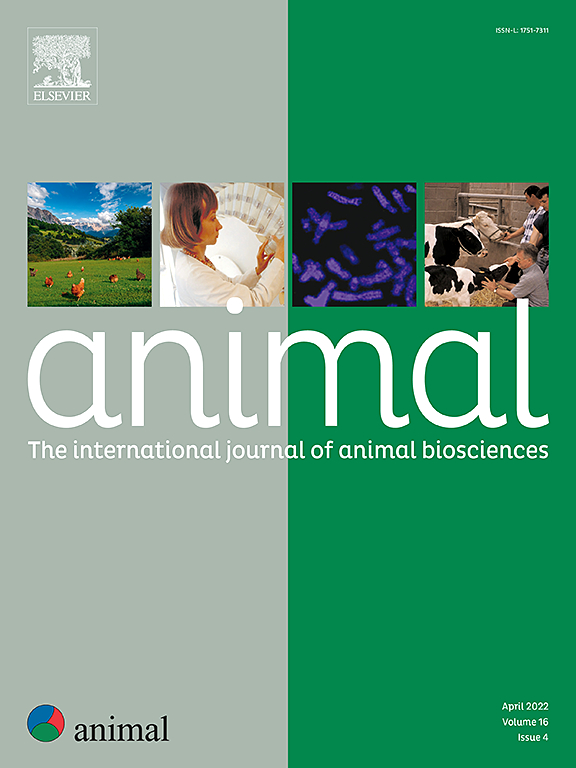评估鹌鹑环境效应跨代传递的传性模型
IF 4.2
2区 农林科学
Q1 AGRICULTURE, DAIRY & ANIMAL SCIENCE
引用次数: 0
摘要
遗传和非遗传信息,有助于表型的发展,可以跨代传递。非遗传信息可以被环境改变,从而使环境影响传递给下一代。本研究的目的是采用鹌鹑实验设计,结合传播率模型,证明环境效应的垂直传播。这项研究包括创建两条线:一条是控制线,另一条是治疗线,其中雌性鹌鹑被喂食含有染料木黄酮的饮食。染料木素是一种影响甲基化模式的内分泌干扰物。然后,以镜像交配设计对这些系进行了三代的繁殖,共研究了1566只动物。研究人员对鹌鹑进行了行为测试,测量它们的运动活动,并在1、4和7周龄时称重。屠宰时记录胴体和腹部脂肪重量。传输率模型是一种混合模型,具有固定的饲养条件,性别,世代,测量时的年龄和染料木素(对动物,胚胎和生殖细胞)的直接影响以及动物传播潜力的随机效应,传输率矩阵包含传递的父系和母系路径系数,必须与遗传模型相反估计,其中它们固定为0.5。环境的遗传率模型包含了染料木素喂养的水坝后代的额外协方差,然后通过水坝和水坝传递给下一代。根据似然比检验选择模型。体重的传递方差比例从0.34(第1周)到0.72(第7周)不等,行为性状的传递方差比例为0.20,肥胖的传递方差比例为0.22。母径系数和坝径系数在0.42 ~ 0.52之间,与0.50之间差异不显著。在环境传递率模型下,体重性状的附加协方差显著大于零,表明染料木素的效应具有跨代传递性。该值在第1周呈高相关性(0.44),但与其他体重性状呈低相关性。环境遗传模型表明,染料木素诱导的环境效应对鹌鹑体重性状的影响是跨代传递的,可能是由表观遗传介导的。研究结果表明,有益的环境因素可以对多代产生积极影响,并将其与遗传选择相结合,可以加速对新环境挑战的适应。本文章由计算机程序翻译,如有差异,请以英文原文为准。
Transmissibility model to evaluate transgenerational transmission of environmental effects in quails
Both genetic and non-genetic information, which contribute to the development of phenotypes, can be transmitted across generations. Non-genetic information can be modified by the environment, allowing environmental effects to be transmitted to the next generation. The objective of the present study was to use an experimental design in quail combined with the transmissibility models, to demonstrate the vertical transmission of environmental effects. The study involved creating two lines: a control line and a treatment line, where female quails were fed a genistein-supplemented diet. Genistein is an endocrine disruptor that affects methylation patterns. Then, reproduction of these lines was conducted in a mirrored mating design over three generations, with a total of 1 566 animals studied. Quails underwent behavioural tests measuring locomotor activity and were weighed at one, four, and 7 weeks of age. At slaughter, body and abdominal adipose weights were recorded. The transmissibility model was a mixed model with fixed effects of rearing condition, sex, generation, age at time of measurement and direct effect of the genistein (on the animal, embryo and germ cells) and the random effect of the transmissible potential of the animal which transmissibility matrix contains sire and dam path coefficients of transmission that have to be estimated conversely to the genetic model where they are fixed to 0.5. The transmissibility model with environment included additional covariance for offspring of genistein-fed dams which is then transmitted to next generations via sires and dams. Models were chosen according to the likelihood ratio test. The proportion of transmitted variance varied from 0.34 (at 1 week) to 0.72 (at 7 weeks) for BW, 0.20 for the behavioural trait and 0.22 for adiposity. The estimated sire and dam path coefficients ranged from 0.42 to 0.52, but were not significantly different from 0.50. With the transmissibility model with environment, the additional covariance was significantly different from zero for BW traits, indicating transgenerational transmission of genistein’s effects. This value corresponded to a high correlation at 1 week (0.44) but low for other BW traits. The transmissibility model with environment demonstrated the transgenerational transmission of genistein-induced environmental effects on BW traits in quail, putatively mediated by epigenetic inheritance. The findings suggest that beneficial environmental factors can positively impact multiple generations, and combining this with genetic selection could accelerate adaptation to new environmental challenges.
求助全文
通过发布文献求助,成功后即可免费获取论文全文。
去求助
来源期刊

Animal
农林科学-奶制品与动物科学
CiteScore
7.50
自引率
2.80%
发文量
246
审稿时长
3 months
期刊介绍:
Editorial board
animal attracts the best research in animal biology and animal systems from across the spectrum of the agricultural, biomedical, and environmental sciences. It is the central element in an exciting collaboration between the British Society of Animal Science (BSAS), Institut National de la Recherche Agronomique (INRA) and the European Federation of Animal Science (EAAP) and represents a merging of three scientific journals: Animal Science; Animal Research; Reproduction, Nutrition, Development. animal publishes original cutting-edge research, ''hot'' topics and horizon-scanning reviews on animal-related aspects of the life sciences at the molecular, cellular, organ, whole animal and production system levels. The main subject areas include: breeding and genetics; nutrition; physiology and functional biology of systems; behaviour, health and welfare; farming systems, environmental impact and climate change; product quality, human health and well-being. Animal models and papers dealing with the integration of research between these topics and their impact on the environment and people are particularly welcome.
 求助内容:
求助内容: 应助结果提醒方式:
应助结果提醒方式:


